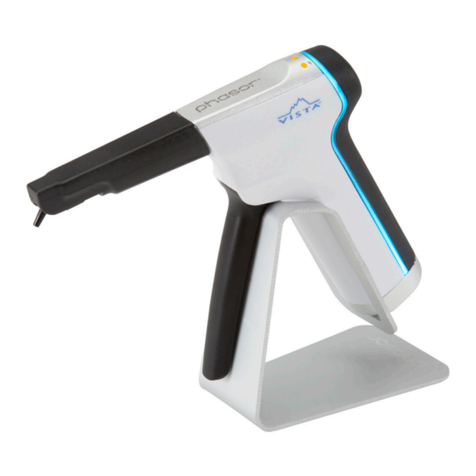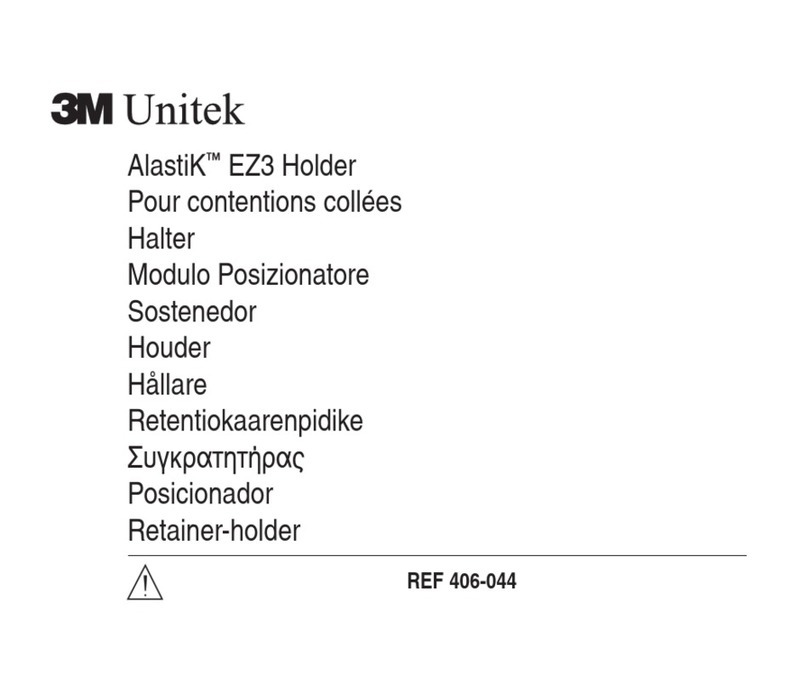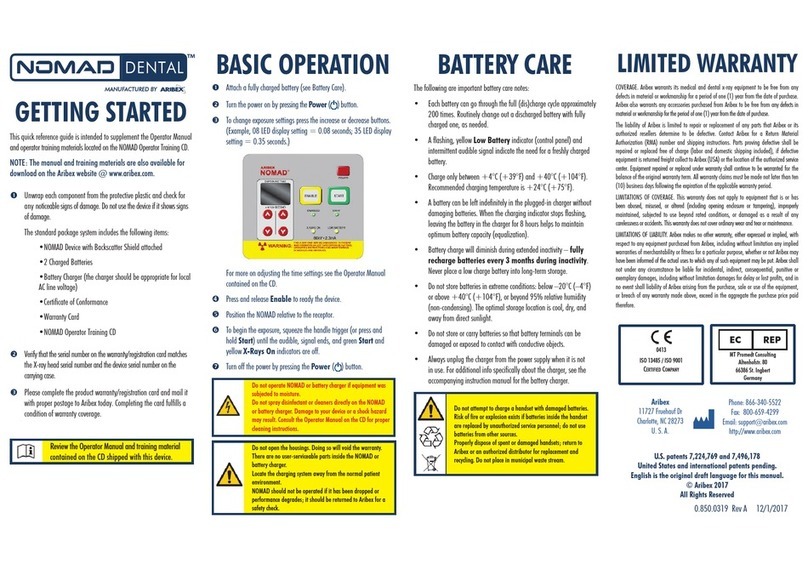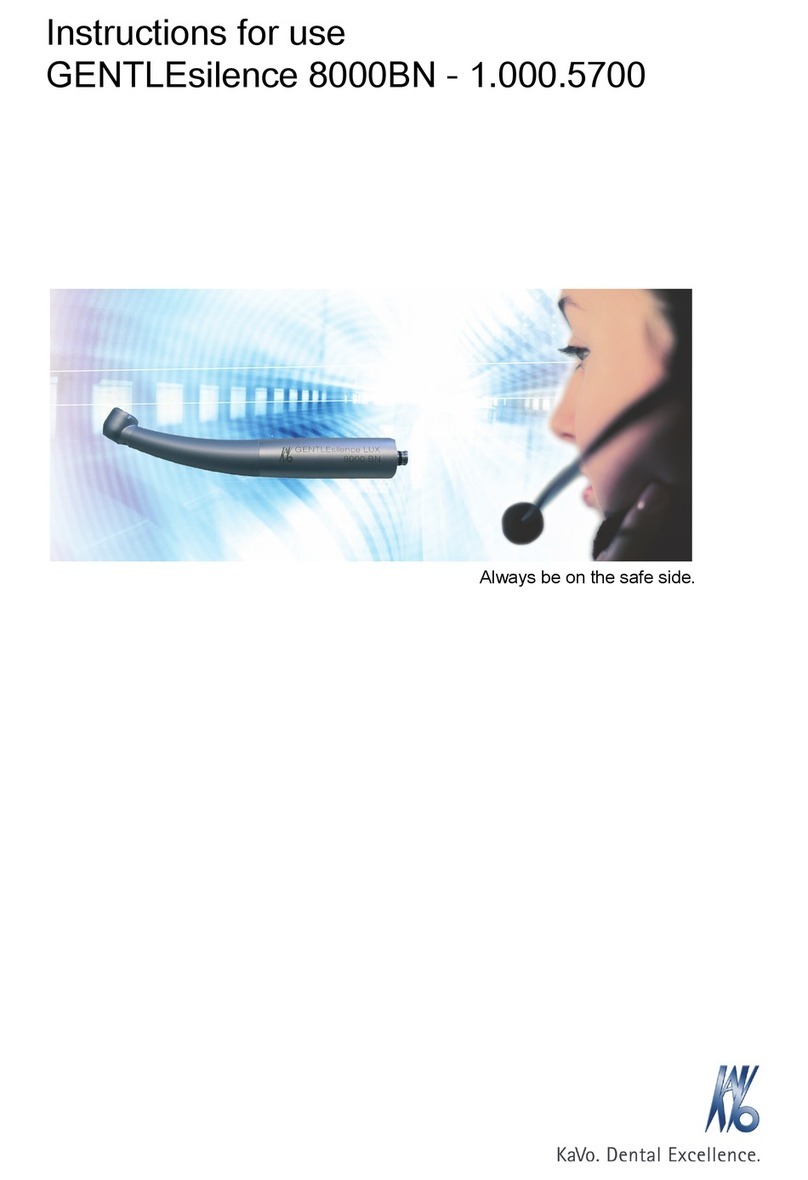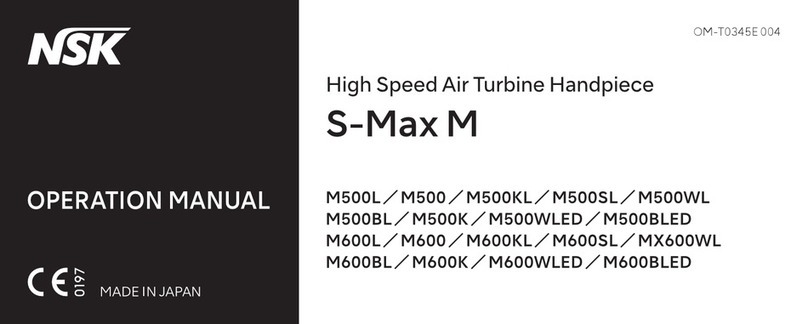FINO VITESSE SF Operation manual

FINO VITESSE SF
50862
Original FINO
Germany
Mikromotor
Micromotor
Micromoteur
Micromotor
Micromotore
Micromotor
Mikromotor
Mikrosilnik
Gebrauchsinformation•User Information•Mode d’emploi
Información sobre el uso•Informazioni d’uso
Gebruiksaanwijzing•Instrukcja stosowania
FINO
•der feine Unterschied•the fine difference•la fine différence•la fina diferencia•la fine differenza

Version 1/2010. Vor Beginn aller Arbeiten Betriebsanleitung lesen!
1. Field of application 3
2. Safety precautions 3
3. Commencement of operation 3
• Assembly
4. Operation 4
• Basic functions • Handpiece • Working with the FINO VITESSE Micromotor
5. Maintenance and cleaning 5
• Removal of chuck • Separation of crank and motor • Change of motor cable
• Adjustment of magnetic sensor of knee-control plate • Testing of individual components
• Replacement of unit fuse
6. Storage 7
7. Technical data 7
8. Delivery includes 7
9. Guarantee 7
10. Troubleshooting 8
• Error codes • Emergency maintenance
11. Important 10
12. Disposal 10
• Registration number
13. Accessories 10
14. Components 11
TABLE OF CONTENTS
2

1. Field of application
The FINO Micromotor is a brush-free micromotor
suitable for all work in the dental lab or workshop. It
particularly excels in high performance and speed
stability. The control unit can either be used as
tabletop or knee controlled unit. If used as a tabletop
unit an additional foot switch for speed control can
be installed. The control unit is equipped with seve-
ral safety features to avoid any damage to the hand-
piece. All wearing parts are easily and economically
to replace.
2. Safety precautions
Safe operation and protection of the unit are only
ensured as long as it is used in compliance with spe-
cifications described in the user information using
only permitted tools. Additionally the following must
be observed:
• The directions of the manufacturer if the tools
• Never exceed the maximum allowed speed
of the tool in use
• Always wear eye protection and facemask
• The occupational safety regulations
• The accident prevention regulations
• Never operate the unit with moist hands!
If the safety precautions are not observed the hazard
of injuries for you and people in your surroundings
exists. FINO does not undertake any guarantee in
the case that these safety precautions are not obser-
ved!
3. Commencement of operation
Please check the unit for transportation damages
immediately after unpacking. All transportation
damages must be claimed promptly. Check the vol-
tage given on the type label of the unit and make
sure it corresponds with your mains supply.
3.1 Assembly
3.1.1 Tabletop unit
Danger of stumbling
Install all cables in a way that they do not
cause any occupational hazard. Place the con-
trol unit on an even and dry surface.
Push the knee-control plate 2
completely in and place the
tabletop stand 3 on the bottom
surface of the control unit.
Subsequently screw on the
tabletop stand 3 using the
included two screws. Place the
control unit on your workplace.
Now connect the plug of the
motor cable 5 with the socket 4
on the back of the control unit.
Thereby make sure that the
groove of the socket and the gap of the plug are
opposite each other. Tighten the nut firmly. Now you
connect the plug of the foot switch 7 with the socket
6. Also here the groove of the socket and the gap of
the plug must be opposite each other. Finally you
connect the power supply cable 9 with the power
supply socket 8. Put the control unit on the therefore
selected place on your workplace. Before you con-
nect the power plug with the mains socket check
again whether all cables are firmly connected to the
control unit.
3.1.2 Knee-control unit
Use only the included screws for
the fitting of the attachment
bracket. The use of other screws
could result in the damage of the
unit or your workbench.
We recommend installing the
attachment bracket 10 in a height
of approx. 520-580 mm depen-
ding on your body height. Mark
the holes with a pencil.
Make sure that the attachment
bracket 10 is kept horizontally. If
necessary use a water level. Drill
the holes with a thin drill. Screw
the screws completely in to
ensure a frictionless installation
of the control unit.
3
ENU

Slide the control unit forward on the attachment
bracket until it markedly catches.
Now connect the plug of the motor cable 5 with the
socket 4 on the back of the control unit. Thereby
make sure that the groove of the socket and the gap
of the plug are opposite each other. Tighten the nut
firmly. Finally you connect the power supply cable 9
with the power supply socket 8. Before you connect
the power plug with the mains socket check again
whether all cables are firmly connected to the con-
trol unit.
4. Operation
For the connection of the motor handpiece or the
foot switch switch the on/off switch 16 to position 0
(off).
4.1 Basic functions
4.1.1 Control unit
Switch the control unit 1 with the on/off switch 16 on.
Select the desired maximum speed between 1.000
and 50.000 rpm with the speed control 11. The range
between 40.000 and 50.000 rpm is blocked by a lock.
Pushing the lock button at the speed control 11 can
disengage this lock. Your selected maximum speed
is shown in the display 15. By pushing the hand/foot-
switch 12 you can switch between hand and foot con-
trol. If the control light next to the hand/foot-switch
12 glows the speed can be adjusted with the foot
switch or the knee-control plate. Pushing the directi-
on selector 13 sets the direction of rotation. If the
control light next to the direction selector 13 glows
the motor turns clockwise. If it is not glowing the
motor turns anti-clockwise (topview on the axis of
rotation). The motor switch 14 allows an automatic
locking of the selected speed. If the control light
next to the motor switch glows orange the function is
activated. If it glows green the function is deactivat-
ed. If a speed is kept for more than two seconds it is
automatically stored and you can release the foot
switch or knee-control plate. The storage of the
speed is indicated by an acoustic signal. By actua-
ting the previously used control device afresh the
speed can again be changed.
4.1.2 Handpiece
4.1.2.1 Opening of chuck
When the chuck is open the
motor is blocked. To prevent
damage to the motor or the
drive parts make sure that
after each change of tools the
chuck has been completely
closed. Never open the chuck while the motor is in
operation! Always operate the device with a tool!
Even if the device is not operated it is recommended
to insert a tool or the test drill and to close the
chuck. To prevent a falling down of the handpiece
always place it on the included handpiece tray 22.
The procedure is described for right-handers.
Lefthanders please proceed diametrically.
Take the handpiece 21 in your
right hand. The motor 20 is thus
in the palm of your right hand.
Take the crank 18 in your left
hand and turn the crank approx.
A quarter revolution clockwise
until you feel a marked resistance. The chuck is open
and the tool can be removed.
4.2 Working with the FINO VITESSE
Micromotor
Before you start with your work
check the selected speed.
Whenever you work with the FINO
VITESSE Micromotor wear pro-
tective eyewear and a facemask!
Never exceed the maximum speed and the maximum
allowed processing pressure of the tool in use!
Before each use check the firm fit of the tool! During
operation never try to hold or to block the tool or the
chuck! Never operate the unit with wet or moist
hands! If your workplace is unsuitably illuminated a
stroboscopic effect may occur. At certain speeds it
causes the impression that the tool does not turn.
This effect can only be prevented with a suitable illu-
mination. Switch the control unit off as long as it is
not in use. Always place the handpiece on the there-
fore provided handpiece tray. Insert the selected
tool into the chuck. See section 4.1.2. Make sure that
the tool is firmly fitting in the chuck. Turn the speed
selector 11 completely left to the lowest speed. Now
switch the control unit with the on/off switch 16 on.
Select the desired maximum speed.
4

4.2.1 Application as tabletop unit
without foot switch
If you want to use the unit as tabletop unit without
foot switch the control light next to the hand/foot
switch 12 must be off. If that is not the case push the
hand/foot switch 12. Simultaneously the control light
next to the motor switch 14 extinguishes. Select the
direction of rotation of the motor by pushing the
direction selector 13. Now you can start the motor by
pushing the motor switch 14. The selected maximum
speed can at any time be changed by turning the
speed control 11. Likewise the direction of rotation
can at any time be reversed by pushing the direction
selector 13. It is not necessary to stop the motor
beforehand. The motor stops when the motor switch
14 is pushed again.
4.2.2 Application as tabletop unit
with foot switch
If you want to use the unit as tabletop unit with foot
switch the control light next to the hand/foot switch
12 must be glowing. If that is not the case push the
hand/foot switch 12. Simultaneously the control light
next to the motor switch 14 glows. Select the directi-
on of rotation of the motor by pushing the direction
selector 13. Now you can start the motor by actuating
the foot switch 7. The selected maximum speed can-
not be changed during the operation of the motor.
The direction of rotation can at any time be reversed
by pushing the direction selector 13. It is not neces-
sary to stop the motor beforehand. If the control light
next to the motor switch 14 glows orange and you
work more than two seconds at a constant speed the
speed is stored and you can remove the foot from
the foot switch 7. To change the speed or to stop the
motor you actuate the foot switch 7 again and sub-
sequently release it completely.
4.2.3 Application as knee-control unit
without foot switch
If you want to use the unit as knee-control unit
without foot switch the control light next to the hand/
foot switch 12 must be glowing. If that is not the case
push the hand/foot switch 12.
Simultaneously the control light next to the motor
switch 14 glows. Select the direction of rotation of
the motor by pushing the direction selector 13.
Now you can start the motor by actuating the knee-
control plate 2. The selected maximum speed cannot
be changed during the operation of the motor. The
direction of rotation can at any time be reversed by
pushing the direction selector 13. It is not necessary
to stop the motor beforehand. If the control light next
to the motor switch 14 glows orange and you work
more than two seconds at a constant speed the
speed is stored and you can release the knee-
control plate 2. To change the speed or to stop the
motor you actuate the knee-control plate 2 again and
subsequently release it completely.
4.2.4 Application as knee-controlled
unit with foot switch
If you want to use the unit as knee-control unit with
foot switch the control light next to the hand/foot
switch 12 must be glowing. If that is not the case
push the hand/foot switch 12.
Simultaneously the control light next to the motor
switch 14 glows. Select the direction of rotation of
the motor by pushing the direction selector 13. Now
you can start the motor by actuating the knee-con-
trol plate 2 or the foot switch 7. The selected maxi-
mum speed cannot be changed during the operation
of the motor. The direction of rotation can at any
time be reversed by pushing the direction selector
13. It is not necessary to stop the motor beforehand.
If the control light next to the motor switch 14 glows
orange and you work more than two seconds at a
constant speed the speed is stored and you can
release the knee-control plate 2 or the foot switch 7.
To change the speed or to stop the motor you actua-
te the knee-control plate 2 or the foot switch 7 again
and subsequently release it.
5. Maintenance and cleaning
For maintenance work on the unit disconnect the
plug from the mains socket. Clean the unit only with
a dry cloth! It is recommended to clean the chuck
thoroughly at least once a week. The chuck may only
be screwed in hand-firm! Do not clean the handpiece
with compressed air!
5
ENU

5.1 Removal of chuck
Open the chuck 23 as
described in section
4.1.2. Insert a tool or
the included test drill
19. Now you place the
included maintenance tool 24 on the chuck and un-
screw it anti-clockwise. Clean the chuck thoroughly
with compressed air or in an ultrasonic bath. Sub-
sequently reinsert the chuck and tighten it.
5.2 Separation of crank and motor
The procedure is described
for right-handers. Lefthan-
ders please proceed diame-
trically. Take the handpiece
in your right hand. The
motor 20 is thus in the palm of your right hand. Take
the crank 18 in your left hand and turn the crank
clockwise until you feel a marked resistance. Now
turn the crank further until motor and handpiece
separate from each other. For the assembly of the
two parts you proceed in reversed order and screw
crank and motor firmly together. Turn the crank a
quarter revolution backwards to close the chuck.
5.3 Change of motor cable
The plug of the motor cable only fits in one position
on the motor. Do not try to force the plug on the
motor. This could damage the connector pins and
makes the motor unserviceable. The procedure is
described for right-handers. Lefthanders please pro-
ceed diametrically.
Take the handpiece back-
wards in your left hand. The
motor thus is in the palm of
your left hand. Unscrew
with your right hand the
protective sleeve anti-clockwise. Carefully pull the
motor cable. The plug connection comes loose. Put
the new motor cable carefully on the motor and
screw the protective sleeve clockwise tightly on.
5.4 Adjustment of magnetic sensor
of knee-control plate
The speed is leadlessly controlled through a magne-
tic sensor on the knee-control plate. It may happen
that the sensor must be adjusted from time to time.
Switch the control unit off. Press the hand/foot
switch 12 and the direction selector 13 simultaneously
and keep both switches pressed. Now switch the unit
on. After approx. 2 seconds you will hear an acoustic
signal and the display shows one of the three options
Hi, Lo or rc. Turn the speed control 11 until the display
shows Hi. Now push the knee-control plate comple-
tely in and keep it there. Acknowledge with the
direction selector 13. You will hear an acoustic
signal. The maximum knee-control plate position has
been stored. Turn the speed control 11 now until the
display shows Lo. The knee-control plate must not
be pressed. Acknowledge with the direction selector
13. You will hear an acoustic signal. The minimum
knee-control plate position has been stored. You
can finish the adjustment now.
Turn the speed control 11 now until the display shows
rc and acknowledge with the direction selector 13.
Switch the control unit off and subsequently on
again. The unit is now ready for operation.
5.5 Testing of individual components
Here the function of the different components can be
tested. To load the respective menu, switch the unit
off. Press the direction selector 13 and the motor
switch 14 now and keep them pressed down. Switch
the unit on. After approx. 2 seconds you will hear an
acoustic signal. By turning the speed control 11 you
can choose from the different options. You can only
choose the option Sc after the lock button on the
speed control has been pressed. You start the test
routine by pushing the direction selector 13. You end
the test routine by again pushing the direction
selector 13.
6

5.6 Replacement of unit fuse
Remove the fuse holder using a flat blade driver.
Replace the damaged fuse with the spare fuse,
which is inside the fuse holder. Put the fuse holder
back. Order a new 250 V/3,15 A fuse.
6. Storage
Store thee unit in a dry and dust-free place.
7. Technical data
Control unit:
Voltage: 220 - 240 V; 50/60 Hz
Power consumption: 40 VA
Exterior dimensions: W 94 x D 268 x H 228 mm
Weight: 2,9 kg
Handpiece:
Dimensions: L 159 mm, ø 27 mm
Speed: 1.000 - 50.000 rpm
Cable length: 1,4 m
Weight: 230 g (without cable)
Foot switch:
Cable length: 1,8 m
Weight: 384 g
Tabletop stand:
Dimensions: W 122 x D 268 x H 30 mm
Weight: 152 g
Handpiece tray:
Dimenstions: W 60 x D 110 x H 45 mm
Weight: 68 g
8. Delivery includes
Control unit, Tabletop stand, Motor handpiece,
Motor handpiece tray, Foot switch, Attachment bra-
cket for control unit, Maintenance tools, Test drill.
9. Guarantee
Our technical recommendations of application are
based on our own experiences and tests and should
only be regarded as guidelines. It rests with the skills
and experience of the user to verify that the products
supplied by us are suitable for the intended proce-
dures. Our products are undergoing a continuous
further development. We reserve the right of chan-
ges in construction and composition. It is under-
stood that we guarantee the impeccable quality of
our products.
7
ENU
Test setting Function Test procedure
Sc Switch Test the function of the switch and its control light
by pressing the switches 12, 13 and 14.
dc Display All segments of the display are switched on one after the other.
Hc Motor sensor Turn the motor shaft to test the function of the motor sensors.
The display shows two bars in different heights.
Fc Foot switch Press the foot switch. The display shows 0-9 and A-F.
nc Knee control plate Press the knee-control plate. The display shows 0-9 and A-F.

8
10. Troubleshooting
10.1 Error codes
Error code Status Possible reason
1E Motor sensor error 1. The motor cable is damaged or not connected.
2. The motor sensor is damaged.
2E Motor blocking error 1. The chuck is open.
2. The handpiece is damaged.
3E Overload protection error 1. The unit was operated under overload conditions.
2. The motor cable resp. the power cable is damaged.
4E Over-voltage protection error 1. The control unit is damaged.
2. The power supply is interrupted.
5E Overheating error 1. The unit was operated under overload conditions.
2. The control unit is overheated.
It should never be exposed to direct sunlight.
6E Overload error After normal starting the motors has blocked.
7E oder 8E Self-test error The control unit has a malfunction.

9
ENU
10.2 Emergency maintenance
Error code
1E
2E
3E
4E
5E
6E
7E + 8E
Problem
The unit cannot be switched on.
The motor
does not run.
The foot switch does not work.
The knee-control plate does not work
or not properly.
The handpiece gets unusually hot
during operation.
The handpiece vibrates and makes
unusual noises.
The chuck does not hold the tool.
What to check
Check whether the unit is switched on.
Check whether the power supply cable is connected
properly.
Check whether the fuses in the unit or your mains
circuit breakers have tripped.
Check whether the motor cable is connected properly.
Test the function of the motor sensor and the motor
cable. See section 5.5.
Make sure that the chuck is closed.
The unit was operated under overload for some time.
The power voltage fluctuates.
The unit was operated under overload for some time.
The control unit is too hot.
The temperature sensor is damaged.
Make sure that the chuck is closed.
Test the smooth rotation of the motor.
The control unit has determined a malfunction.
Check whether the foot switch cable is connected
properly.
Test the function of the foot switch.
The knee-control plate was pressed while the unit
was switched on.
Test the function of the knee-control plate.
The ball bearing is worn.
The chuck is dirty.
The used tool is not balanced or the speed is
too high for the tool.
The ball bearing is worn.
The chuck is loose.
The chuck is worn.
The used tool is to thin.
Help
Switch the unit on by pressing the on/off switch 16.
Connect the power supply cable properly.
Replace fuses.
Connect the motor cable properly. If the error is
still displayed replace the motor cable.
1. Replace the motor cable.
2. The motor sensor is damaged.
Close the chuck.
Switch the unit off and let it cool for
approx. 10 minutes.
1. Check the power voltage. It must correspond
to the voltage indicated on the type label.
2. Switch the unit off. Wait for approx. 5 seconds
and switch it on again.
Switch the unit off and let it cool for approx.
10 minutes.
Take care that the control unit is never exposed
to direct sunlight. Switch the unit off and let cool.
Let the technical customer service replace the
sensor.
Close the chuck.
Turn the chuck with your hand.
It must move smoothly and without noise.
Switch the unit off. Wait for approx. 5 seconds
and switch it on again. If the error still persists
contact the technical customer service.
Connect the cable properly.
See section 5.5, Test setting Fc.
Switch the unit off. Wait for approx. 5 seconds and
switch it on again. If the error still persists contact
the technical customer service.
See section 5.5, Test setting nc.
Replace the ball bearing with a new one.
Clean the chuck as described in section 5.1.
Use a new tool. Observe the maximum allowed
speed of the used tool.
Replace the ball bearing with a new one.
Screw in the chuck hand-firm
Replace the chuck.
Use a tool with a shank diameter of 2,35 mm.
Should the above-mentioned measures not be successful or should you encounter problems that are not described here, please contact the technical
customer service.

12. Disposal in accordance with
EC Guideline 2002/96/EG
This equipment may not be disposed in
domestic waste! Please contact the manu-
facturer or your dealer!
12.1 Registration number
30926170
10
11. Important!
The FINO GmbH has compiled the present user infor-
mation to the effect to support the user in the opera-
tion of the units and to facilitate the implementation
and operation of the unit. The FINO GmbH is not
responsible for damages that are attributed to an
incorrect application or alterations of the unit. An
application for purposes other than the described
leads to the loss of the guarantee. According to its
policy FINO GmbH permanently further develops its
products. FINO reserves the right to put on changes
or improvements to the products described in this
documentation or the document itself without prior
notice. FINO does not undertake any guarantee for
the completeness or correctness of the contents of
this document.
7-10 FINO TC-Cutters
Shank-ø 2,35 mm, ISO 104.
Recommended speed range for
all TC milling cutters:
Acc. to ISO 023 5-50.000 rpm
ISO 023-045 15-40.000 rpm
ISO 045-080 15-30.000 rpm
Cross-cut fine
Smoothens surfaces and enables the
delicate shaping of each structure.
Suitable for all dental materials.
13. Accessories
1-6 FINO DIADISC
1+2 Very flexible diamond discs.
Double-sided 3 mm circular coating with
fine grain (D 30); for crown and bridge work.
3+4 Very flexible diamond discs.
Double-sided 3 mm circular coating with
coarser fine grain (D 54);
5+6 Stable diamond discs with long service-life;
cutting on the edge, double-sided full coating
with coarser fine grain (D 54).
023 045 060 060
P-60364 C-60365 C-60366 C-60367
789 10
ISO: 190 220 190 220 190 220
Thickness: 0,14 0,14 0,20 0,20 0,30 0,30
T-65900 X-65901 Z-65904 Z-65905 Z-65908 Z-65909
1 2 3 4 5 6

14. Components
11
ENU
13 Direction selector
14 Motor switch
15 Display
16 On/off switch
17 Chuck
18 Crank
19 Test drill
20 Motor
21 Handpiece
22 Handpiece tray
23 Protective sleeve
24 Maintenance tool
1Control unit
2Knee-control plate
3Tabletop stand
4Socket for motor cable
5Motor cable
6Socket for foot switch
7Foot switch
8Socket for power supply
9Power supply cable
10 Attachment bracket
11 Speed control
12 Hand/foot switch

FINO GmbH
Mangelsfeld 18
D-97708 Bad Bocklet
Tel +49-97 08-90 94 20
Fax +49-97 08-90 94 21
This manual suits for next models
1
Table of contents
Popular Dental Equipment manuals by other brands
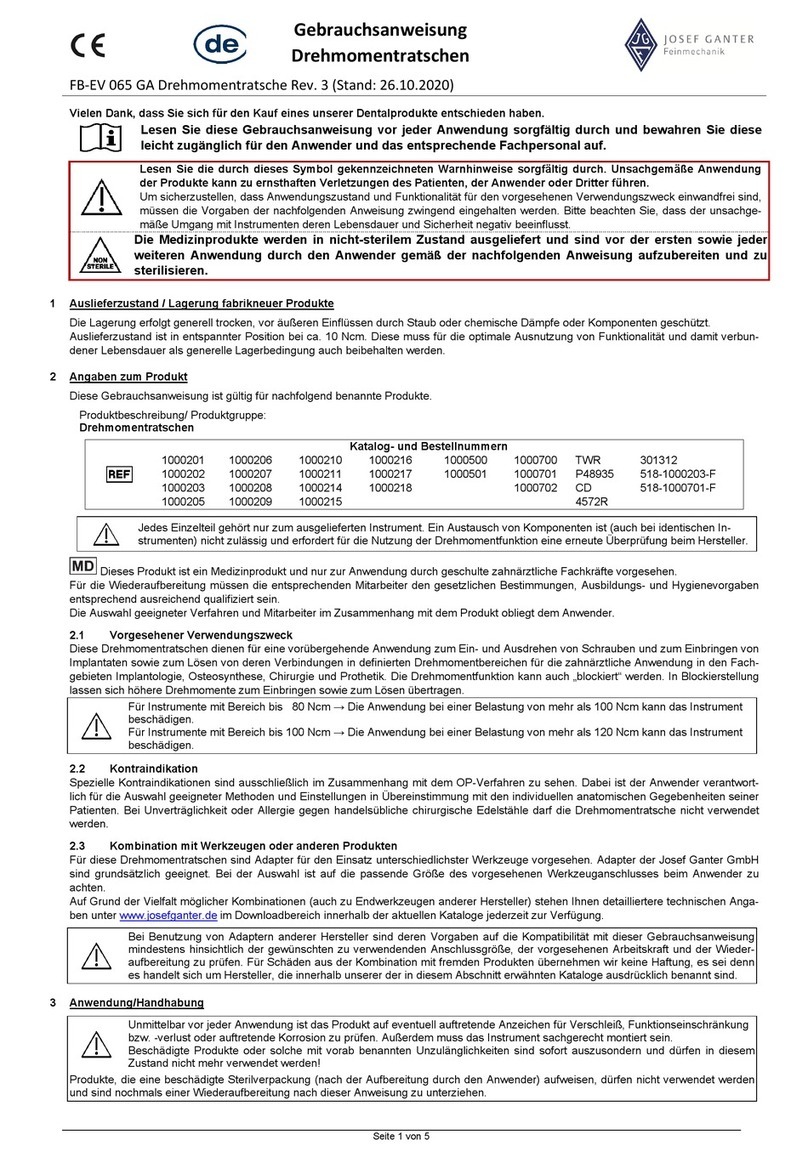
Josef Ganter Feinmechanik
Josef Ganter Feinmechanik FB-EV 065 GA User instructions

Bien Air
Bien Air CA 1:1 Instructions for use
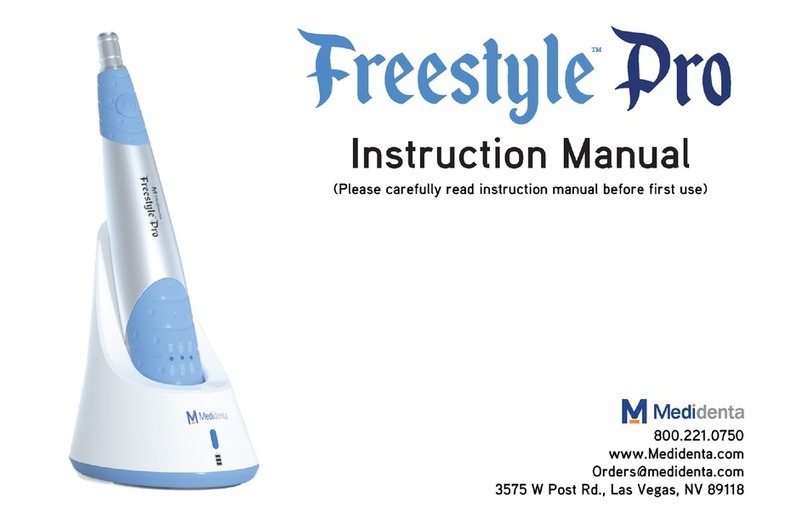
Medidenta
Medidenta Freestyle Pro instruction manual

Renfert
Renfert SIMPLEX 3D-Filament-Drucker manual
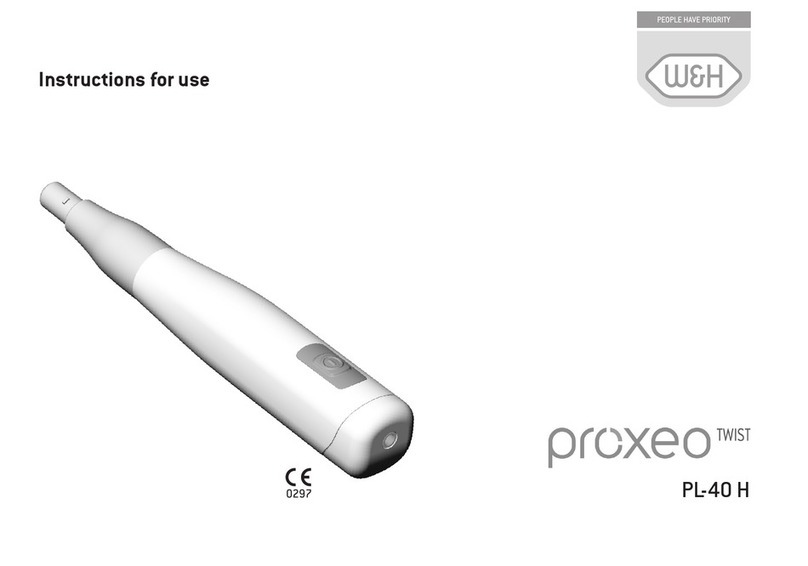
W&H
W&H proxeo TWIST PL-40 H Instructions for use
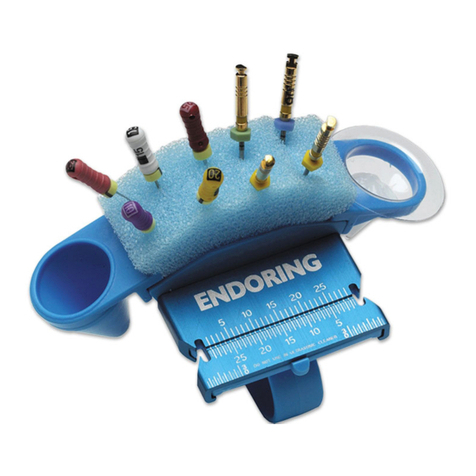
Jordco
Jordco ENDORING II Instructions for use
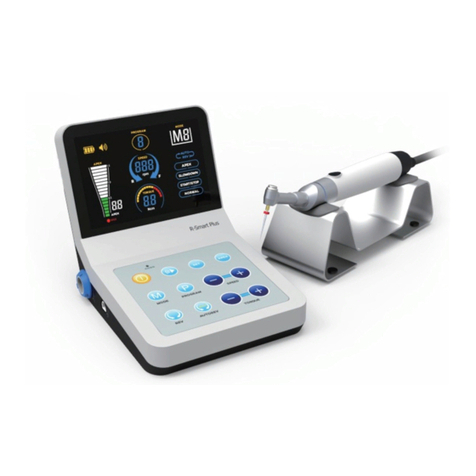
Reborn Endo
Reborn Endo R-SMART PLUS user manual
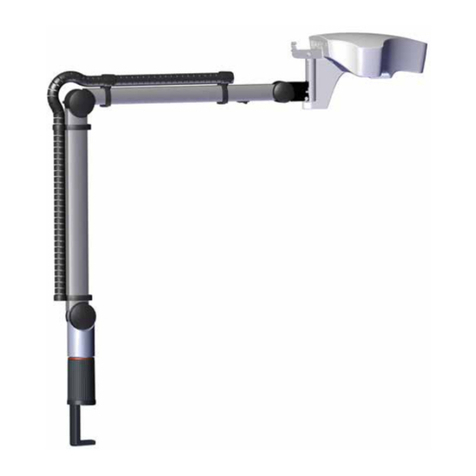
Renfert
Renfert EASY view 3D quick start guide
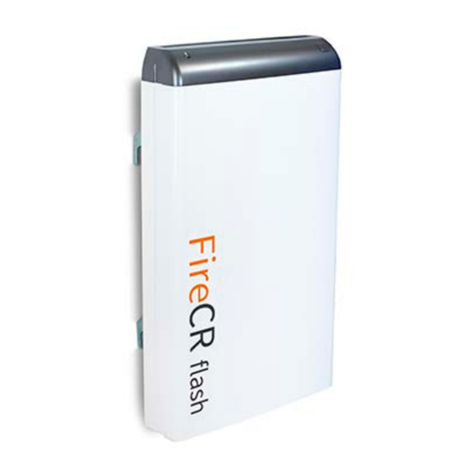
Digiray
Digiray FireCR Flash installation manual
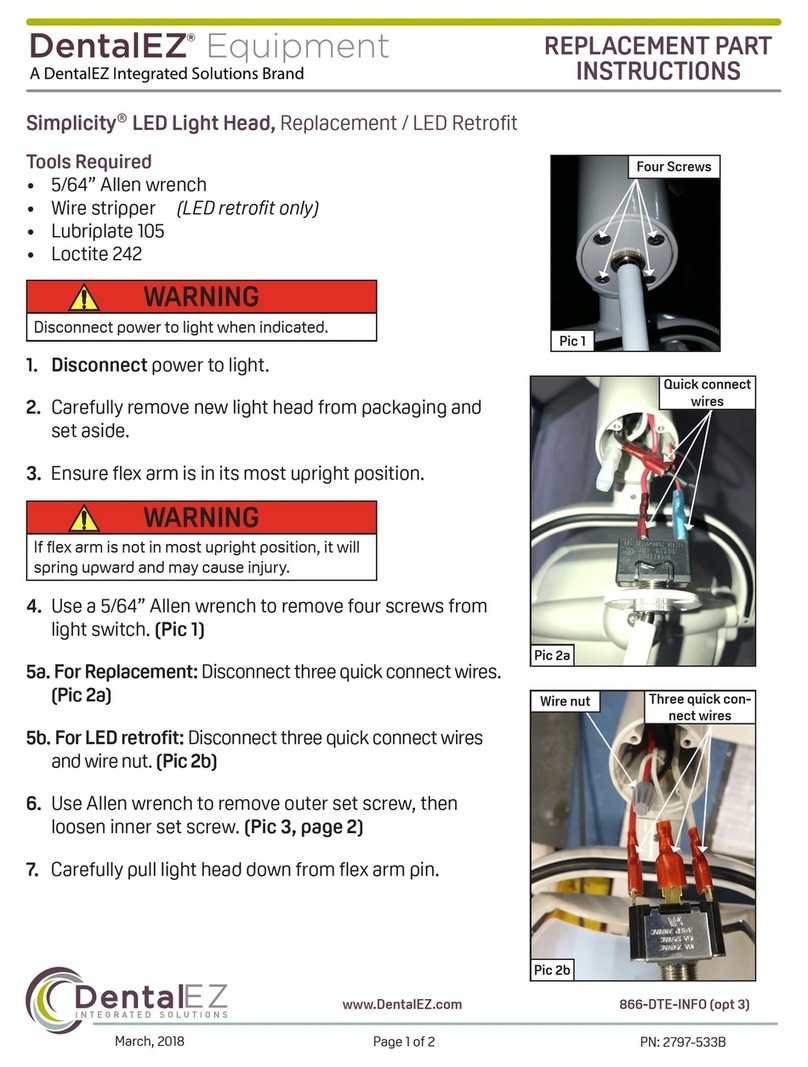
DentalEZ
DentalEZ Simplicity LED Light Head REPLACEMENT PART INSTRUCTIONS
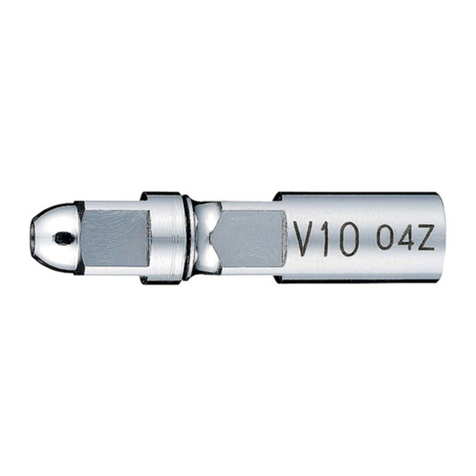
Nakanishi
Nakanishi NSK V10 instruction manual

Digital Doc
Digital Doc IRIS Installer manual
